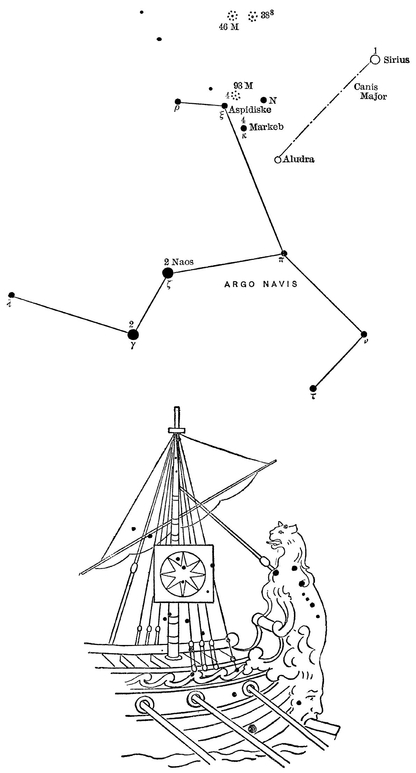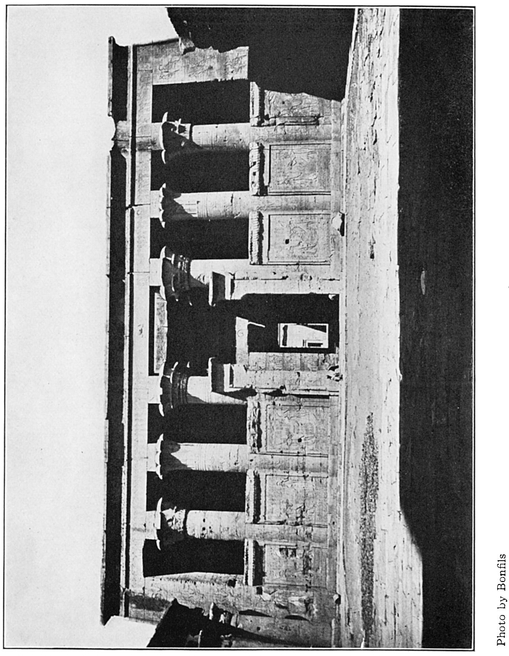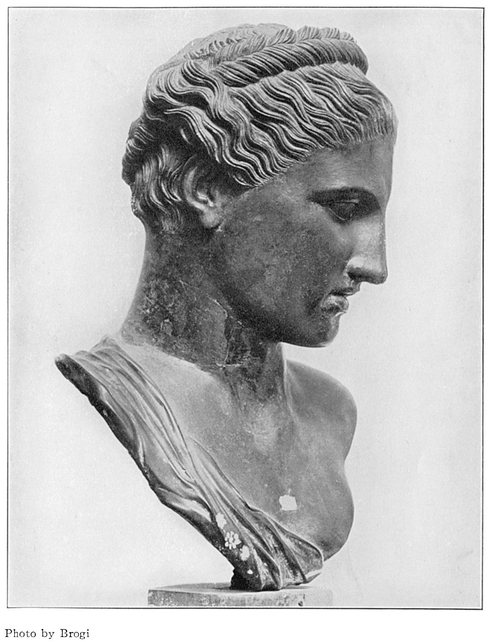The Minor Constellations

ARGO NAVIS
THE MINOR CONSTELLATIONS
| Argo Navis | The Ship Argo |
| Camelopardalis | The Giraffe |
| Columba Noæ | Noah’s Dove |
| Coma Berenices | Berenice’s Hair |
| Lacerta | The Lizard |
| Leo Minor | The Lesser Lion |
| Lynx | The Lynx |
| Monoceros | The Unicorn |
| Sagitta | The Arrow |
| Sextans | The Sextant |
| Scutum Sobiescanum | Sobieski’s Shield |
| Triangulum | The Triangle |
| Vulpecula cum Ansere | The Fox with the Goose. |
ARGO NAVIS
THE SHIP ARGO
Against the tail of the Great Dog is dragged Sternward the Argo, with no usual course But motion contrary.

So sternward labours the Jasonian Argo
Obscure in parts and starless, as from prow
To mast, but other portions blaze with light.
FROTHINGHAM’S Aratos.
ARGO can hardly be called a minor constellation, and owes its place under such a heading to the fact that in these latitudes but a very small part of it is visible, so that only a brief reference to it is necessary.
The Ship, or Argo as it is generally called, lies entirely in the southern hemisphere, east of Canis Major and south of the Unicorn and Hydra. Only the few stars representing the stern of the ship can be seen in the latitude of New York City.
The Ship is figured without a prow, one of the best evidences that chance had no part in the invention of the constellation.
According to mythology Argo was built either by Glaucus, Jason, Argos, or Hercules. It was famous as the first craft that ever ventured to sea, and as the one that bore the Argonautic expedition to Colchis on its quest of the Golden Fleece.
To the Egyptians it represented the ark that bore Osiris and Isis over the Deluge.
Sir Isaac Newton fixed the date of the building of this celebrated craft as 936 B.C.
With the Romans it was generally “Argo,” or “Navis,” and the Arabs called it “a Ship.” To the Biblical school it represented Noah’s Ark.
The lucida of the constellation, never seen in these latitudes, is the first magnitude star Canopus.
CAMELOPARDALIS
THE GIRAFFE
The Giraffe, described as “a long, faint, and straggling” constellation, first appeared on the star map of Bartsch in 1640. It is also found in the catalogue of Hevelius published in 1690, as Camelopardalus.
Prof. E. C. Pickering tells us that the correct spelling according to the best classical authorities, both Greek and Latin, is Camelopardalis.
Bartsch wrote that the group represented to him the camel that brought Rebecca to Isaac.
The Chinese are said to have located seven asterisms within the borders of this star group.

Temple of Edfu

Berenice
Bronze Bust in National Museum, Naples
According to Argelander the constellation contains eighty-four stars, none brighter than the fourth magnitude.
COLUMBA NOÆ
NOAH’S DOVE
The surer messenger,
A Dove sent forth...
The Dove first appeared on Royer’s star map of 1679, although Allen tells us that it had appeared seventy-six years before on Bayer’s plate of Canis Major. It is thought also that Cæsius alluded to it seventeen centuries ago.
The asterism comprises the stars to the south and west of the Greater Dog, and is appropriately situated close to the Ship, which is identified with Noah’s Ark.
Alpha Columbæ bears the modern titles “Phaet,” “Phact,” and “Phad.” The Chinese called this star “the Old Folks.”
Lockyer asserts that twelve different Egyptian temples were oriented to this star, notably those at Edfu and Philæ where Phaet was worshipped as far back as 6400 B.C.
Allen considers the star too inconspicuous to warrant such prominence.
Phaet is a 2.5 magnitude star, situated 33° south of ε Orionis, and culminates at 9 P.M., Jan. 26th.
Beta Columbæ is known as “Wezn” or “Wazn,” meaning the “weight.”
According to Gould, Columba contains seventeen stars.
COMA BERENICES
BERENICE’S HAIR
Now behold the glittering maze of Berenice’s hair.
Eratosthenes was the first to mention this faint yet beautiful cluster, and called it “Ariadne’s Hair,” but Tycho Brahe was the first one to catalogue it as a separate constellation in 1602.
Catullus, in his translation of the Greek of Callimachus, thus refers to the location of Coma Berenices:
Just by the Virgin in the starry sphere,
The savage Lion and Northern Bear
Full to the west with sparkling beam I lead,
And bright Boötes in my course precede.
Allen thinks that the group was known to the Egyptians as “the Many Stars.” Other titles for it are “Berenice’s Periwig,” “Rosa,” and “Berenice’s Bush,” and the figure has been thought to represent the tuft of hair in the Lion’s tail, and the sheaf of wheat held by the Virgin.
The Chinese took a great interest in this group, and gave it many fanciful names.
Burritt gives the following brief history of the constellation: “Berenice was of royal descent, and a lady of great beauty, who married Ptolemy Soter or Euergetes, one of the kings of Egypt, her own brother. When he was going on a dangerous expedition against the Assyrians she vowed to dedicate her hair to the goddess of beauty, if he returned in safety. Sometime after the victorious return of her husband the locks, which she had deposited in the temple of Venus, disappeared. The King expressed great regret at the loss, whereupon Conon his astronomer publicly reported that Jupiter had taken away the Queen’s locks from the temple and placed them among the stars in this figure.”1
According to Argelander there are thirty-six stars in this group.
LACERTA
THE LIZARD
This asterism was designed by Hevelius, and comprises the stars between Cygnus and Andromeda.
1 The early Christians thought that this cluster represented the Scourge of Christ, Absalom’s hair, or Samson’s Hair.
The original figure drawn by Hevelius is described as “a strange weasel-built creature with a curly tail.”
The Chinese knew the stars in this region of the sky as “the Flying Serpent,” and in Royer’s chart, published in 1679, these stars formed the star group known as “the Sceptre and Hand of Justice.”
Argelander mentions thirty-one stars in this constellation, none brighter than 3.9 magnitude.
Lacerta culminates about the middle of April.
LEO MINOR
THE LESSER LION
The Smaller Lion now succeeds; a cohort
Of fifty stars attend his steps.
Hevelius introduced this star group in 1690, forming it from eighteen stars situated between the Greater Lion and Bear. He gave it this title as he said it “partook of the same nature” as the neighbouring figures.
The Chinese included the Greater and Lesser Lion in their great figure of the Dragon.
The zodiacal Crab of the zodiac of Denderah is located in this figure, and this part of the sky was thought to have been sacred to the god Ptah.
Argelander assigned twenty-one stars to this group, none brighter than the fourth magnitude.
LYNX
THE LYNX
The Lynx first made its appearance as a constellation in 1690 on the star map of Hevelius. Originally it was said to contain nineteen stars, which number Burritt has increased to forty-four.
The inventor accounted for the title on the ground that “it was so inconspicuous a star group that only a lynx-eyed person could discern it.”
The Lynx has been known as “the Tiger,” and is noted for the number and beauty of its double stars, of which fifty are mentioned in Webb’s Celestial Objects. The constellation comes to the meridian in February.
MONOCEROS
THE UNICORN
The Unicorn is generally supposed to have been designed by the astronomer Bartsch, but Olbers and Ideler claim that it was invented as early as 1564, and Scaliger is said to have found it on an ancient Persian sphere.
It is situated in the space between Orion, the two Dogs, and the Hydra. The Chinese asterisms, “the Four Great Canals” and “the Outer Kitchen,” lay in this region of the sky.
Argelander assigned sixty-six stars to it, and Heis one hundred and twelve.
Monoceros contains many fine star clusters, but no stars brighter than a 3.6 magnitude.
SAGITTA
THE ARROW
There ’s further shot another Arrow
But this without a bow. Towards it the Bird
More northward flies.
ARATOS.
This ancient figure is situated in the Milky Way directly north of the Eagle, and has occasionally appeared as held in the Eagle’s talons.
“It has been regarded as the traditional weapon that slew the eagle of Jove, or the one shot by Hercules toward the adjacent Stymphalian birds.”—ALLEN.
Eratosthenes considered it to be the shaft with which Apollo exterminated the Cyclops, and it has been regarded as the Arrow of Cupid.
In classical times Sagitta was thought to represent the Reed from which arrows were formed.
The Hebrews, Armenians, Persians, and Arabians all knew it as an Arrow.
Cæsius considered it the shaft winged by Joash at Elisha’s command, or one of those sent by Jonathan towards David at the stone Ezel.
Schiller thought it represented the spear or the nail of the Crucifixion.
According to Argelander it contains sixteen naked eye stars, none brighter than the fourth magnitude.
It culminates on Sept. 1st.
ζ Sagittæ is a triple star, and “an interesting system,” says Allen.
SEXTANS
THE SEXTANT
This is a modern asterism sometimes called “Urania’s Sextant,” and first appeared on the chart of Hevelius which was published in 1690.
This celestial Sextant is supposed to commemorate the sextant so successfully used by Hevelius in taking stellar measurements at Dantzig from 1658 to 1679.
The astronomer von Rheita imagined that this group represented Saint Veronica’s Sacred Handkerchief.
The original figure of the Sextant comprised the twelve unclaimed stars between Leo and Hydra, west of Crater, and it has been generally recognised by astronomers since the date of its invention.
The lucida of the group, a fourth magnitude star, is situated 12° south of Regulus.
According to Argelander the Sextant contains seventeen naked eye stars.
SCUTUM SOBIESCANUM
SOBIESKI’S SHIELD
Hevelius was the first to introduce this figure, which appeared in his star chart of 1690. It is situated in the Milky Way, west of Aquila, between the tail of the Serpent and the head of Sagittarius.
The figure is that of the Coat of Arms of the third John Sobieski, King of Poland, a distinguished warrior.
The group is generally styled “Scutum,” and, according to Heis, contains eleven stars, none brighter than the fourth magnitude.
In China these stars comprise an ancient figure known as “the Heavenly Casque.”
There are several fine clusters in this region, and it is said that within the boundaries of Scutum, in a space five degrees square, Sir Wm. Herschel estimated that there were 331,000 stars.
TRIANGULUM
THE TRIANGLE
Beneath Andromeda. Three lines compose
The Triangle. On two sides measured equal,
The third side less. It is not difficult
To be discerned. More luminous than many.
FROTHINGHAM’S Aratos.
The Triangle is an asterism of considerable antiquity, and was evidently more noticed by the ancients than by us.
It is situated between Andromeda and Aries, and in the following allusion to it by the poet Manilius there is a reference to its early Greek title, Δελτωτóν, from the likeness the figure bears to the Greek letter Delta (Δ):
Five splendid stars in its unequal frame
Deltoton bears, and from the shape a name.
With the Romans and astronomers of the 17th century it was known as “ Deltotum.” It was also called “Delta,” and associated with Egypt and the Nile, hence its title “the Home of the Nile.”
The Triangle has been likened to the Trinity, and the Mitre of St. Peter.
The figure is noted as marking the location of the discovery of the minor planet Ceres by Piazzi, Jan. I, 1800.
The 3.6 magnitude star Alpha Trianguli bears the title “Caput Trianguli.” It culminates at 9 P.M., Dec. 6th.
α and β Trianguli were known as “the Scale Beam.”
According to Argelander the group contains fifteen stars.
VULPECULA CUM ANSERE
THE FOX WITH THE GOOSE
This is one of several constellations invented by Hevelius in 1690, and appearing for the first time in his star chart published in that year.
It is situated between the Arrow and the Swan, where the Milky Way divides into two branches.
Hevelius is said to have selected this figure because of its appropriateness to its position, as the fox was a cunning and voracious animal, and was placed near the Eagle and Vulture which are of the same rapacious and greedy nature.
The figure is now generally known as “Vulpecula,” and contains a noteworthy object in the “Double-headed Shot” or “Dumb-Bell nebula.” The group also marks the radiant point of the “Vulpeculids,” a meteor shower appearing from June 13th to July 7th.
According to Argelander the asterism contains thirty-seven stars.